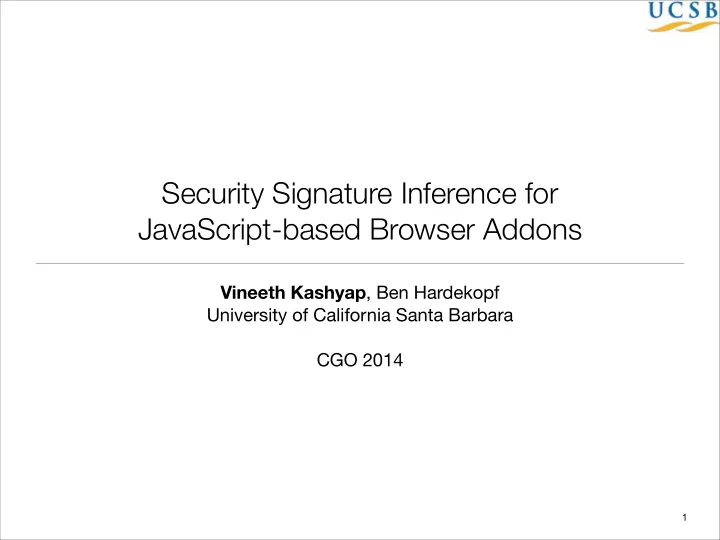

Security Signature Inference for JavaScript-based Browser Addons Vineeth Kashyap , Ben Hardekopf University of California Santa Barbara � CGO 2014 � 1
JavaScript-based Browser Addons � 2
Addons: JavaScript with High Privileges � 3
Urging Security Concern • Proof of concept exploits • FFSni ff , a configurable password stealer • Unintentional vulnerabilities • Wikipedia Toolbar allowed arbitrary privileged code execution • Intentionally malicious • Key loggers � 4
Curated Repositories � 5
� 6
� 7
� 8
� 9
� 10
Manual JavaScript Addon Vetting is Difficult • Ad-hoc • Tedious • Error-prone � 11
Our Goal: Help Automate the Vetting Process • Automatically infer security signatures • Summarize interesting information flows and critical API usages � 12
Our Goal: Help Automate the Vetting Process • Automatically infer security signatures • Summarize interesting information flows and critical API usages � 12
Our Goal: Help Automate the Vetting Process • Automatically infer security signatures • Summarize interesting information flows and critical API usages � 12
Our Goal: Help Automate the Vetting Process • Automatically infer security signatures • Summarize interesting information flows and critical API usages amplified local control flow url send (www.evil.com) � 12
Key Challenges • Flexible security policies • No single policy applies for all addons • Classifying Information Flows • Binary result (secure or insecure) is not enough • Inferring Network Domains • Critical to reason about addon’s network communication � 13
Our Solution • Construct annotated Program Dependence Graphs (PDG) • Use annotated PDGs to generate security signatures • Use prefix string analysis to infer network domains communicated with � 14
Our Solution • Construct annotated Program Dependence Graphs (PDG) • Use annotated PDGs to generate security signatures • Use prefix string analysis to infer network domains communicated with � 14
Our Solution • Construct annotated Program Dependence Graphs (PDG) • Use annotated PDGs to generate security signatures • Use prefix string analysis to infer network domains communicated with � 14
Our Solution • Construct annotated Program Dependence Graphs (PDG) • Use annotated PDGs to generate security signatures • Use prefix string analysis to infer network domains communicated with Automatically summarize API usages, interesting information flows (classified based on the type of flow) � 14
Annotated Program Dependence Graph • Use JSAI † to construct a PDG • Annotate the edges of PDG with the type of dependency † JSAI is a sound and e ffj cient JavaScript abstract interpreter we developed. � 15
Strong vs. Weak Data Dependency 1 var data = {loc: url, other: 1} 2 send(data[“loc”]); 3 send(data[getString()]); � 16
Strong vs. Weak Data Dependency 1 var data = {loc: url, other: 1} 2 send(data[“loc”]); 3 send(data[getString()]); � 16
Strong vs. Weak Data Dependency 1 var data = {loc: url, other: 1} 2 send(data[“loc”]); 3 send(data[getString()]); � 16
Local Control Dependency 5 if (url == "secret.com") 6 send(null); � 17
Local Control Dependency 5 if (url == "secret.com") 6 send(null); � 17
Syntax-obvious Non-local Control Dependency 13 try { 14 if (url != "hush-hush.com") 15 throw "irrelevant"; 16 send(null); 17 } catch(x) {}; 14 � 18
Syntax-obvious Non-local Control Dependency 13 try { 14 if (url != "hush-hush.com") 15 throw "irrelevant"; 16 send(null); 17 } catch(x) {}; 14 � 18
Non-obvious Non-local Control Dependency 18 try { 19 if (url != "mystic.com") 20 obj.prop = 1; 21 send(null); 22 } catch(x) {} � 19
Non-obvious Non-local Control Dependency 18 try { 19 if (url != "mystic.com") 20 obj.prop = 1; 21 send(null); 22 } catch(x) {} � 19
Amplified vs. Simple Control Dependencies 7 var arr = ["covert.com", "priv.com"/*,..*/]; 8 var i=0, count=0; 9 while (arr[i] && url != arr[i]) { 10 i++; 11 count++; } // end while 12 send(count); � 20
Amplified vs. Simple Control Dependencies 7 var arr = ["covert.com", "priv.com"/*,..*/]; 8 var i=0, count=0; 9 while (arr[i] && url != arr[i]) { 10 i++; 11 count++; } // end while 12 send(count); � 20
Lattice of Perceived Flow Strength Stronger � Flow � 21
Lattice of Perceived Flow Strength data Stronger � Flow control � 22
Lattice of Perceived Flow Strength Stronger � Flow amplified not amplified � 23
Lattice of Perceived Flow Strength Stronger � local Flow non local � 24
Lattice of Perceived Flow Strength Stronger � Flow syntax obvious non obvious � 25
Generating Security Signatures • Use the PDG to reason about information flow in addons • Use PDG annotations to classify flows • Output a signature summarizing relevant flows � 26
Generating Security Signatures • Use the PDG to reason about information flow in addons • Use PDG annotations to classify flows • Output a signature summarizing relevant flows amplified local control flow url send (www.evil.com) � 26
Generating Security Signatures � 27
Generating Security Signatures � 27
Generating Security Signatures � 27
Generating Security Signatures � 28
Generating Security Signatures � 29
Generating Security Signatures � 29
Generating Security Signatures � 30
Generating Security Signatures � 31
Generating Security Signatures � 32
Generating Security Signatures � 33
Generating Security Signatures � 33
Generating Security Signatures amplified local control flow url send (www.evil.com) � 33
Evaluation • Evaluated analysis on 10 real addons from Mozilla repository • Manually created security signatures based on submitted addon description • Ran the analysis to get inferred signature, compared against our manual signature • Possible experimental outcomes: • pass (no unexpected information flow) • fail (false unexpected information flow) • leak (true unexpected information flow) � 34
Results † † † In all these cases, the failure was due to insu ffi cient precision in the string domain. � 35
Conclusion • Browser addon vetting is hard, needs automation • Security signatures are useful to understand security behavior of addons Implementation available under the Downloads link at � http://www.cs.ucsb.edu/~pllab � 36
Acknowledgements • Tommy Ashmore and Ben Wiedermann (Harvey Mudd College) • Dave Herman (Mozilla Research) • Mozilla Addon Vetting Team � 37
Questions? vineeth@cs.ucsb.edu � 38
Recommend
More recommend